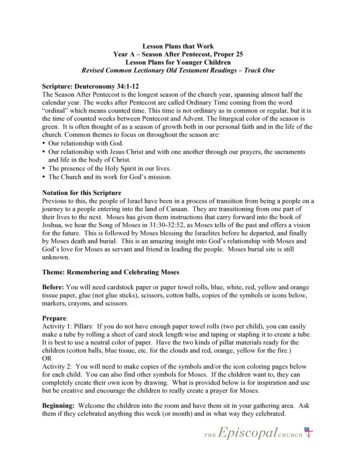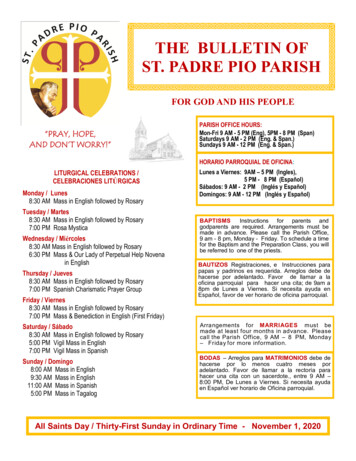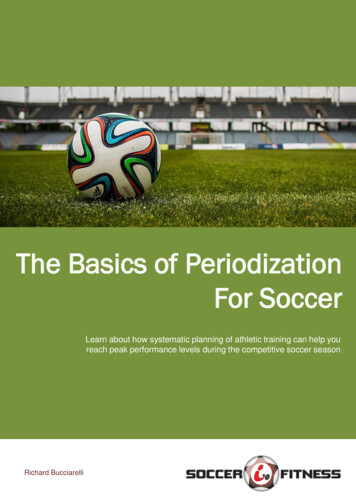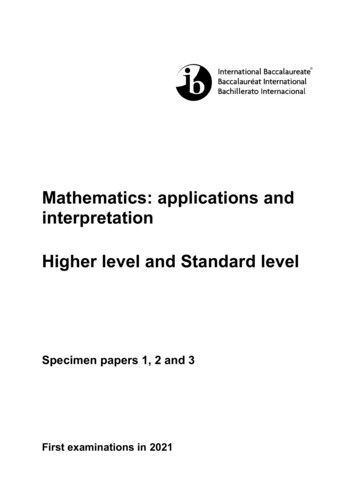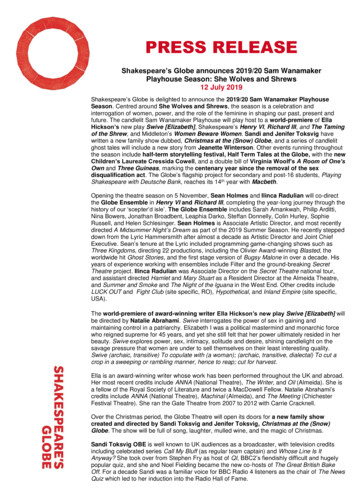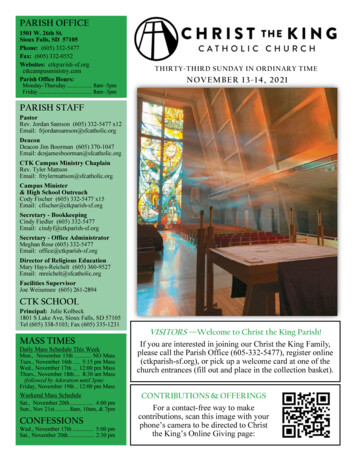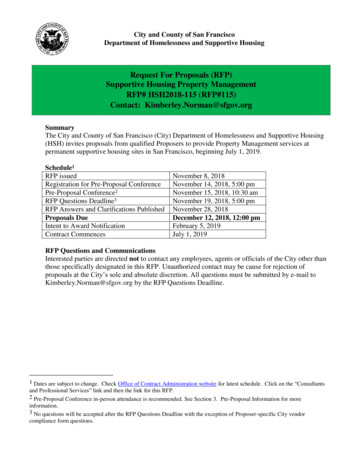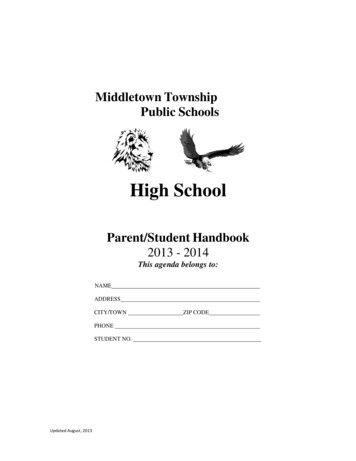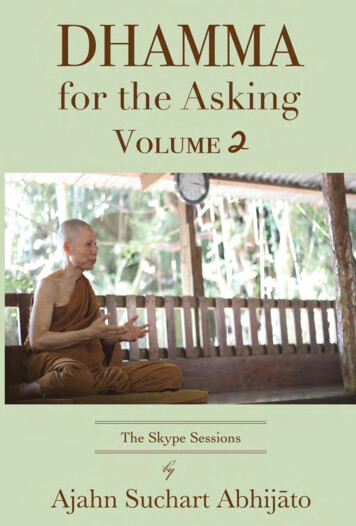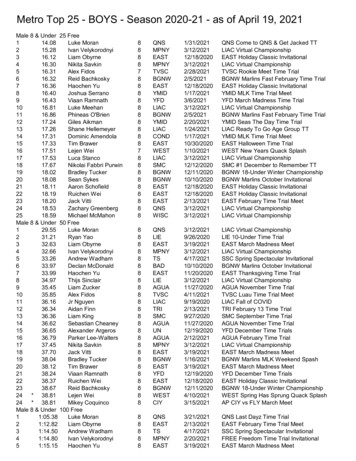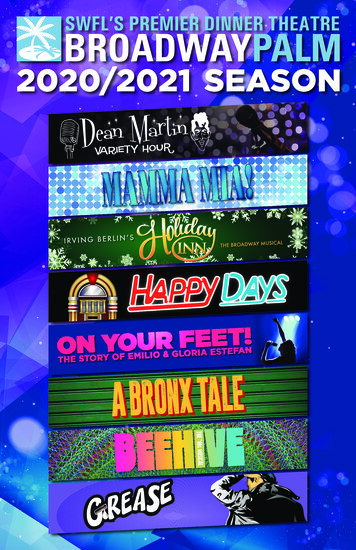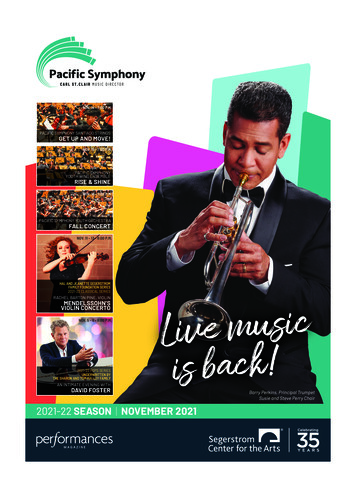
Transcription
NOV. 14 7:00 P.M.PACIFIC SYMPHONY SANTIAGO STRINGSGET UP AND MOVE!NOV. 15 7:00 P.M.PACIFIC SYMPHONYYOUTH WIND ENSEMBLERISE & SHINENOV. 16 7:00 P.M.PACIFIC SYMPHONY YOUTH ORCHESTRAFALL CONCERTNOV. 11 – 13 8:00 P.M.HAL AND JEANETTE SEGERSTROMFAMILY FOUNDATION SERIES2021-22 CLASSICAL SERIESRACHEL BARTON PINE, VIOLINMENDELSSOHN’SVIOLIN CONCERTONOV. 5 – 6 8:00 P.M.2021-22 POPS SERIESUNDERWRITTEN BYTHE SHARON AND TOM MALLOY FAMILYAN INTIMATE EVENING WITHDAVID FOSTERL ive musicis back!Barry Perkins, Principal TrumpetSusie and Steve Perry Chair2021-22 SEASON NOVEMBER 2021PS 2021 November Cover APPROVED.indd 19/30/21 10:10 AM
PROGRAMGabriela Lena FrankConcertino CusqueñoMendelssohnViolin Concerto in E Minor,Op. 64Allegro molto appassionatoAndanteAllegretto non troppo Allegro molto vivaceRachel Barton Pine, violin— Intermission —RACHEL BARTON PINE, VIOLINPHOTO BY LISA-MARIE MAZZUCCOCaroline ShawEntr’actePacific Symphony PremiereCoplandSuite From Appalachian SpringThis concert is being recorded forbroadcast on Sunday, December 19, 2021,on Classical KUSC.2021-22 Hal and Jeanette SegerstromFamily Foundation Classical SeriesMENDE L S S O H N ’ SV I OL I N C O NC E RTOABOUT THE ARTISTPreview Talk with Dr. Jacob Sustaita @ 7 p.m.Thursday, November 11, 2021 @ 8 p.m.Friday, November 12, 2021 @ 8 p.m.Saturday, November 13, 2021 @ 8 p.m.Teddy Abrams, conductorRachel Barton Pine, violinPacific SymphonyOFFICIAL TV STATIONOFFICIAL MUSIC STATIONPerformance at the Segerstrom Center for the ArtsRenée and Henry Segerstrom Concert HallP6PERFORMANCES MAGAZINEIn both art and life, violinist Rachel Barton Pine hasan extraordinary ability to connect with people.Celebrated as a leading interpreter of great classicand contemporary works, her performances combineher innate gift for emotional communication and herscholarly fascination with historical research. Sheplays with passion and conviction, thrilling audiencesworldwide with her dazzling technique, lustrous toneand infectious joy in music-making.Pine performs with the world’s leading orchestras,including the Philadelphia Orchestra, the RoyalPhilharmonic Orchestra, Camerata Salzburg and theChicago, Vienna and Detroit Symphony Orchestras. Shehas worked with renowned conductors, including MarinAlsop, Semyon Bychkov, Neeme Järvi, Erich Leinsdorf,Sir Neville Marriner, Nicholas McGegan, Zubin Mehta,Tito Muñoz and John Nelson, and has collaboratedwith artists such as Daniel Barenboim, ChristophEschenbach and William Warfield.Pine frequently performs music by contemporarycomposers, including major works written for her byBilly Childs, Mohammed Fairouz, Marcus Goddard, EarlManeein, Shawn E. Okpebholo, Daniel Bernard Roumain,José Serebrier and Augusta Read Thomas. She hasPacific Symphony 2021-22 Season November 2021 PACIFICSYMPHONY.ORG
r,Op. 64natoeSpringpremiered concertos written for her by Fairouz, Goddardand Maneein. In 2020, she premiered Violin Concerto No.2, written for her by Billy Childs through a co-commissionby the Grant Park Music Festival, the Boulder PhilharmonicOrchestra, the Anchorage Symphony Orchestra and theInterlochen Orchestra.Pine’s prolific discography of 39 recordings includesDvořák and Khachaturian Violin Concertos (Teddy Abramsand the Royal Scottish National Orchestra); Brahms &Joachim Violin Concertos (Carlos Kalmar and the ChicagoSymphony Orchestra) and Elgar & Bruch Violin Concertos(Andrew Litton and the BBC Symphony Orchestra). Pine andSir Neville Marriner’s Mozart: Complete Violin Concertos withthe Academy of St Martin in the Fields and her Bel CantoPaganini both charted at number three on the classicalcharts. Pine’s Testament: Complete Sonatas and Partitas forSolo Violin by Johann Sebastian Bach and Violin Lullabiesdebuted at number one. Her Violin Concertos by BlackComposers of the 18th and 19th Centuries was nominated fora 1997 NPR heritage award. Her recent Blues Dialogues isan album of blues-influenced classical works by 20th- and21st-century Black composers.Pine has appeared on The Today Show, CBS SundayMorning, PBS NewsHour, Prairie Home Companion, NPR’s TinyDesk, NPR’s All Things Considered and Performance Today,and in The Wall Street Journal, Los Angeles Times and TheNew York Times. She holds prizes from several of the world’sleading competitions, including a gold medal at the 1992J.S. Bach International Violin Competition.She performs on the “ex-Bazzini, ex-Soldat” JosephGuarnerius “del Gesù” (Cremona 1742), on a lifetime loanfrom her anonymous patron.ABOUT THE CONDUCTORAn unusually versatile musician, Teddy Abrams isthe widely acclaimed music director of the LouisvilleOrchestra. Now in his eighth season as music director,Teddy has fostered interdisciplinary collaborations with theLouisville Ballet and Speed Art Museum, and led Louisville’scultural response to the pandemic with the “Lift Up Lou”initiative. Among other works, the 2021-22 season includesthe world premieres of Abrams’ new piano concerto writtenfor Yuja Wang and a concerto for timba band and orchestracomposed by Grammy winner Dafnis Prieto. His rap-opera,The Greatest: Muhammad Ali, premiered in 2017, celebratingLouisville’s hometown hero with an all-star cast thatincluded Rhiannon Giddens and Jubilant Sykes, as well asJecorey “1200” Arthur, with whom he started the LouisvilleOrchestra Rap School. Abrams’ work with the LouisvilleOrchestra has been profiled on CBS Sunday Morning,NPR, The Wall Street Journal, PBS’ Articulate and the PBSNewsHour.Teddy Abrams has been music director and conductor ofthe Britt Festival Orchestra since 2013, where, in additionto an annual three-week festival of concerts, he has takenthe orchestra across the region in the creation of newwork—including Michael Gordon’s Natural History, whichwas premiered on the edge of Crater Lake National Park inpartnership with the National Parks Service and was thesubject of the PBS documentary Symphony for Nature; andPulitzer Prize-winning composer Caroline Shaw’s Brush, anexperiential work written to be performed this summer onthe Jacksonville Woodlands Trail system.Abrams recently collaborated with Jim James, vocalistand guitarist for My Morning Jacket, on the song cycle TheOrder of Nature, which they premiered with the LouisvilleOrchestra in 2018 and recorded on Decca Gold. Theyperformed the work with the National Symphony Orchestraat the Kennedy Center in 2019. Teddy Abrams records onUniversal Music Group’s Decca Gold Label. In addition toThe Order of Nature, Abrams and the Louisville Orchestrarecorded All In in 2017 with vocalist Storm Large.Highlights of Abrams’ 2021-22 season includeengagements with the Buffalo Philharmonic, SarasotaOrchestra and New World Symphony. As a guest conductor,he has worked with such distinguished ensembles as theLos Angeles Philharmonic; the San Francisco, National,Houston, Indianapolis, Milwaukee, Vancouver, Colorado,Utah and Phoenix Symphonies; Saint Paul ChamberOrchestra; and the Florida Orchestra. Internationally, hehas worked with the Royal Scottish National Orchestra,Orchestre Philharmonique du Luxembourg, and theMalaysian Philharmonic. Abrams served as AssistantConductor of the Detroit Symphony from 2012-2014. From2008 to 2011, he was the Conducting Fellow and AssistantConductor of the New World Symphony.TEDDY ABRAMSPACIFICSYMPHONY.ORG November 2021 Pacific Symphony 2021-22 SeasonPERFORMANCES MAGAZINEP7
PROGRAM NOTESGabriela Lena Frank:Concertino CusqueñoIdentity has always been at the centerof composer/pianist Gabriela LenaFrank’s music. Born in Berkeley,California (September, 1972) to amother of mixed Peruvian/Chineseancestry and a father of Lithuanian/Jewish descent, Gabriela exploresher multicultural heritage through hercompositions. Inspired by the worksof Bela Bartók and Alberto Ginastera,Gabriela has traveled extensively throughout South America increative exploration. Her music often reflects not only her ownpersonal experience as a multiracial Latina, but also refract herstudies of Latin American cultures, incorporating poetry, mythologyand native musical styles into a western classical framework that isuniquely her own. While a full measure of enjoyment can be derivedsolely from hearing her works, Gabriela often provides composer’snotes that enhance the listening experience. Regarding ConcertinoCusqueño, she writes:Concertino Cusqueño (Concertino in the Cusco Style) findsinspiration in two unlikely bedfellows: Peruvian culture andBritish composer Benjamin Britten. As a daughter of a Peruvianimmigrant, I’ve long been fascinated by my multicultural heritageand have been blessed to find western classical music to be ahospitable playpen for my wayward explorations. In doing so, I’velooked to composers such as Alberto Ginastera from Argentina,Béla Bartók from Hungary, Chou Wen Chung from China and myown teacher William Bolcom from the US as heroes: To me, thesegentlemen are the very definition of “cultural witnesses,” as theyilluminate new connections between seemingly disparate idiomsof every hue imaginable Though Ms. Frank goes on to include Britten on this illustriouslist—and even speculates how they might have shared Peruvian culturalexperiences, if only she’d had the chance to meet him—her music evokesa brighter, more animated landscape than Britten’s to many listeners.Felix Mendelssohn:Violin Concerto In E MinorBehind the sunny disposition of hismusic lies the seriousness of oneof the great musical intellects of alltime, whose impossible precocity inchildhood was on par with Mozart’s. Inhis tragically short life (he died at age38 in 1847), Mendelssohn achieved astatesmanlike position in Europeanculture, directing one of the continent’smost important orchestras (the Leipzig Gewandhaus) and spurringrevivals of interest in the music of Mozart and J.S. Bach. Most of all,Mendelssohn composed more than his share of indestructible alltime hits of the classical repertoire—works like the violin concerto,the octet, the “Italian” symphony and the incidental music to “AMidsummer Night’s Dream.”Mendelssohn’s gorgeous violin concerto is one of the three orfour most beloved staples of the violin repertory, and is universallyP8PERFORMANCES MAGAZINEregarded as one of the greatest of all violin concertos. Its singingmelodies traverse an arc from poetic sadness to sheer joy. Oncewe hear these tunes, they are ours forever. Or do they possess us,as they seem to have possessed Mendelssohn himself? “I would liketo write a violin concerto for you next winter,” he famously told hislongtime friend, the violinist Ferdinand David, concertmaster of theLeipzig Gewandhaus, in 1838. “One in E minor runs through my head,the beginning of which gives me no peace.” That beginning is theconcerto’s dazzling opening, which plunges into a sweetly melancholystatement in the solo violin without the drama-building introductionthat precedes the soloist’s entrance in most romantic concertos.This songlike opening statement quickly gives way to abravura display of notes that swirl downward until the openingtheme is restated in the orchestra. From then on, the concertopacks in abundantly virtuosic writing. The movement containsan adventurous, complex development through highly chromaticmodulations, introducing a second melody that answers theconcerto’s initially melancholy E minor statement with an answerin tranquil, glowing G major. On the way back to the opening Eminor theme, Mendelssohn leads the soloist through an innovativecadenza that is fully notated (no improvising allowed). Of thismovement’s beautiful features that were modern for their day, noteespecially the “ricocheting” bow, which oscillates over the strings tovoice arpeggios at bullet-speed while the E minor melody is playedby the full orchestra. In passages such as this one, the soloistserves as accompanist—but the playing is spectacular.As the excitement of the opening allegro movement subsides,the bassoon continues to sustain its note—a B—as the rest of theorchestra is silent. Moving up a tone to middle C, the bassoon leads uswithout pause into the concerto’s middle movement, a serene andantein C major. The movement’s lyrical beauty, which opens from E minorinto C major before incorporating a darker middle section in A minor,incorporates fleet passagework for the soloist. But for many listeners,it serves mainly as a transitional movement between the concertossweetly melancholy opening and its joyful closing movement, aneffervescent vivace in E major that sounds like a merry chase throughsunny fields. A boisterous coda concludes the concerto.Speaking on the occasion of his 75th birthday in 1906, the greatviolinist Joseph Joachim aptly described the world’s affection forthe Mendelssohn violin concerto: “The Germans have four violinconcertos. The greatest, most uncompromising is Beethoven’s. Theone by Brahms vies with it in seriousness. The richest, the mostseductive, was written by Max Bruch. But the most inward, theheart’s jewel, is Mendelssohn’s.”Caroline Shaw:Entr’acteWhen Caroline Shaw won the PulitzerPrize for Music in 2013, it caused morethan the usual stir. Shaw was not onlythe youngest composer ever to win theaward, but also one of the few women.Others include Ellen Taaffe Zwilich, 1983;Shulamit Ran, 1991; Melinda Wagner,1999; Jennifer Higdon, 2010; and, morerecently (post-Shaw, that is), JuliaWolfe, 2015; Du Yun, 2017; and Ellen Reid, 2019. Shaw, in particular,was immediately recognized as an astonishing new voice. Herprize-winning composition, Partita for 8 Voices, was composed forthe Grammy-winning vocal ensemble Roomful of Teeth, a fearlesslyPacific Symphony 2021-22 Season November 2021 PACIFICSYMPHONY.ORG
experimental group that defies musical tradition and has rewrittenthe rules of choral singing. Major singers now seek her out, and shehas created works for artists including sopranos Renée Fleming andDawn Upshaw, and mezzo-soprano Anne Sofie von Otter.Born in Greenville, North Carolina, Shaw began playing the violinat age two and writing music at age ten. She received her Bachelorof Music in violin performance from Rice University in 2004 and hermaster’s degree in violin studies from Yale in 2007. She enteredPrinceton University’s PhD program in composition in 2010, andis now based in New York as a vocalist, violinist, composer andproducer. She is a member of Roomful of Teeth.Shaw currently teaches at NYU and is a creative associate at TheJuilliard School. She has held residencies at Dumbarton Oaks, theBanff Centre, Music on Main and the Vail Dance Festival. She lovesthe color yellow, otters, Beethoven opus 74, Mozart opera, Kinhaven,the smell of rosemary and the sound of a janky mandolin.As we listen to Entr’acte, we hear the combination of old andnew that is characteristic of her sound: traditional harmoniesjuxtaposed against startling dissonances; strict rhythms thatgive way to elastic, wayward rhythmic shifts. The effect is oftenvertiginous or dreamlike. Her deeply communicative writing forstrings, which utilizes a wide array of effects, seems to reflect herearly and continuing commitment to the violin. In her composer’snote about Entr’acte, she writes:Entr’acte was written in 2011 after hearing the Brentano Quartetplay Haydn’s Op. 77 No. 2—with their spare and soulful shift tothe D-flat major trio in the minuet. It is structured like a minuetand trio, riffing on that classical form but taking it a little further.I love the way some music (like the minuets of Op. 77) suddenlytakes you to the other side of Alice’s looking glass, in a kind ofabsurd, subtle, technicolor transition.As befits a composition that straddles both sides of Alice’s looking glass,many listeners hear a surreal quality in Entr’acte. As writer Timothy Juddnotes, “Throughout the piece we get subtle glimpses of Classical andBaroque music that has suddenly found itself in the wrong century.”Aaron Copland:Suite FromAppalachian SpringBorn with the 20th century, AaronCopland — with his air of dignity andintellectualism — became known as “theDean of American Composers” later inlife largely for earlier accomplishments,such as his transcendently beautiful andquintessentially American AppalachianSpring. Commissioned as a ballet score by the revolutionaryAmerican choreographer Martha Graham, Appalachian Springwas originally scored for a chamber orchestra of 13 players andpremiered with the Graham company in 1944. Everything aboutthe ballet was instantly recognizable as both new and classic:The dramatic vocabulary of Graham’s dance language; the stark,suggestive set design by artist Isamu Noguchi; and Copland’s score,which found a uniquely American voice. Rescored for full orchestrathe following year, Appalachian Spring won the Pulitzer Prize formusic and became one of the iconic works of American classicalmusic. Copland composed Appalachian Spring without knowingwhat its title would be. The ballet depicts scenes from country lifein 14 brief episodes; though story is set in springtime and focuseson the natural cycle of life’s annual renewal, the “spring” in the titleis actually a brook of life-giving water rather than a season of theyear, a reference Graham found in Hart Crane’s poem “The Dance.”The story culminates in the celebration of its characters, 19thcentury Pennsylvania settlers including a young wedded couple, a“pioneer woman” and a preacher, after building a farmhouse.For Copland, who had studied in Paris with Nadia Boulanger andexplored Schoenbergian atonality, Appalachian Spring representeda reaffirmation of the greatness of America’s musical and culturalheritage. It opens and closes with prayerful chords developed fromtraditional hymns, eventually centering on pastoral variations onthe Quaker hymn “Simple Gifts.” Its climactic setting of this starkmelody combines simplicity and majesty in a way that is profoundlymoving and utterly American.Michael Clive is a cultural reporter living in the Litchfield Hills ofConnecticut. He is program annotator for Pacific Symphony andLouisiana Philharmonic, and editor‑in‑chief for The Santa Fe Opera.Gabriela Lena FrankBorn: Sept. 26, 1972. Berkeley, Calif.Concertino CusqueñoComposed: 2012World premiere: October 25, 2012, Philadelphia OrchestraMost recent Pacific Symphony performance: Nov. 11, 2021Instrumentation: two flutes including piccolo, two oboes, twoclarinets including bass clarinet, two bassoons, two French horns,two trumpets, timpani, percussion, harp, celesta and stringsEstimated duration: 10 minutesFelix MendelssohnBorn: Feb. 3, 1809. Hamburg, GermanyDied: Nov. 4, 1847. Leipzig, GermanyViolin Concerto In E Minor, Op. 64Composed: 1844World premiere: March 13, 1845, Leipzig Gewandhaus OrchestraMost recent Pacific Symphony performance: November 16, 2014with Carl St.Clair as conductor and Chad Hoopes as soloist at SokaUniversity of AmericaInstrumentation: two flutes, two oboes, two clarinets, two bassoons,two French horns, two trumpets, timpani and strings with solo violinEstimated duration: 26 minutesCaroline ShawBorn: Aug. 1, 1982. Greenville, N.C.Entr’acteComposed: 2011World premiere: April 2011 by the Brentano Quartet in its originalstring quartet version at Princeton University.Most recent Pacific Symphony performance: Nov. 11, 2021Instrumentation: strings onlyEstimated duration: 11 minutesAaron CoplandBorn: Nov. 14, 1900. Brooklyn, N.Y.Died: Dec., 2, 1990. North Tarrytown, N.Y.Suite From Appalachian SpringComposed: 1943-1944World premiere: Oct. 4, 1945, New York PhilharmonicMost recent Pacific Symphony performance: May 4, 2011Instrumentation: two flutes including piccolo, two oboes, twoclarinets, two bassoons, two French horns, two trumpets, twotrombones, timpani, percussion, harp, piano and stringsEstimated duration: 23 minutesPACIFICSYMPHONY.ORG November 2021 Pacific Symphony 2021-22 SeasonPERFORMANCES MAGAZINEP9
the Britt Festival Orchestra since 2013, where, in addition to an annual three-week festival of concerts, he has taken the orchestra across the region in the creation of new work—including Michael Gordon’s Natural History, which was premiered on the edge of Crater Lake National Park i
